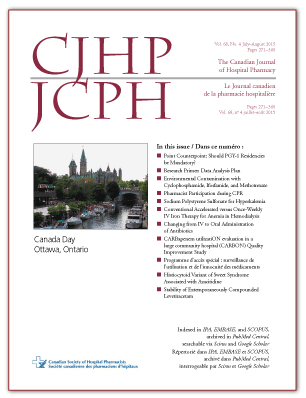Outcomes Associated with Conventional Accelerated Versus Once-Weekly IV Iron Therapy in Outpatients Undergoing Hemodialysis
DOI:
https://doi.org/10.4212/cjhp.v68i4.1470Keywords:
parenteral iron, pharmacist dosing, outpatient, fer parentéral, ajustement posologique par le pharmacien, patient externeAbstract
ABSTRACT
Background: Although parenteral iron replacement is a key aspect of managing anemia in patients who are undergoing hemodialysis, studies evaluating novel iron dosing regimens are scarce.
Objective: To compare the effectiveness of a once-weekly IV iron dosing strategy with that of a conventional accelerated iron dosing regimen in patients undergoing hemodialysis.
Methods: In this retrospective cohort study, patient-specific information was collected for individuals undergoing hemodialysis who received IV iron between June 1, 2010, and June 30, 2012, at a community hospital in southwestern Ontario. The primary outcomes were hemoglobin level and utilization of an erythropoiesis-stimulating agent for 2 groups of patients: those receiving iron according to a once-weekly IV regimen and those receiving iron by a conventional accelerated IV regimen.
Results: Of the 148 patients who met the inclusion criteria, 99 (66.9%) received iron by a conventional accelerated regimen and 49 (33.1%) by a once-weekly IV regimen. Generalized estimating equations developed from 313 observations obtained from these 148 patients suggested that average transferrin saturation percentage and iron concentration were both significantly higher in the group that received iron once weekly than in the group that received iron by the conventional accelerated regimen (p = 0.014 and 0.008, respectively). The mean weekly dose of erythropoiesis- stimulating agent was significantly lower in the once-weekly administration group than in the conventional administration group (7419 versus 10 706 units; p = 0.041). The 2 groups did not differ significantly in terms of hemoglobin concentration (p = 0.46) or ferritin level (p = 0.13).
Conclusions: The findings of this study suggest that a once-weekly iron dosing regimen may be superior to a conventional accelerated dosing regimen for managing iron deficiency anemia in patients who are undergoing hemodialysis.
RÉSUMÉ
Contexte : Bien que la recharge en fer par voie parentérale représente un facteur clé de la prise en charge de l’anémie de patients traités par hémodialyse, il n’y a que très peu d’études évaluant les nouveaux schémas posologiques de fer.
Objectif : Comparer l’efficacité réelle d’une dose hebdomadaire de fer administrée par voie intraveineuse à celle d’un schéma posologique intensif traditionnel de fer chez les patients hémodialysés.
Méthodes : Dans la présente étude de cohorte rétrospective, on a recueilli des données sur des patients traités par hémodialyse qui ont reçu du fer par voie intraveineuse entre le 1er juin 2010 et le 30 juin 2012 dans un hôpital communautaire du sud-ouest de l’Ontario. Les principaux paramètres d’évaluation étaient le taux d’hémoglobine et l’emploi d’un agent stimulant l’érythropoïèse chez deux groupes de patients : l’un recevant du fer à raison d’une dose hebdomadaire par voie intraveineuse et l’autre selon un schéma posologique intensif traditionnel par voie intraveineuse.
Résultats : Parmi les 148 patients ayant satisfait aux critères d’admissibilité, 99 (66,9 %) ont reçu du fer selon un schéma posologique intensif traditionnel et 49 (33,1 %) l’ont reçu à raison d’une dose hebdomadaire par voie intraveineuse. Des équations d’estimation généralisée élaborées à partir de 313 observations obtenues de ces 148 patients laissent croire que les pourcentages moyens de saturation de la transferrine et de la concentration de fer étaient tous deux nettement plus élevés dans le groupe ayant reçu du fer une fois par semaine que dans le groupe en ayant reçu selon le schéma posologique intensif traditionnel (respectivement p = 0,014 et 0,008). La dose hebdomadaire moyenne d’un agent stimulant l’érythropoïèse était significativement plus faible au sein du groupe recevant une dose de fer hebdomadaire que dans le groupe de traitement traditionnel (7 419 contre 10 706 unités; p = 0,041). Les taux d’hémoglobine (p = 0,46) ou de ferritine (p = 0,13) ne variaient pas de façon significative entre les deux groupes.
Conclusions : Selon les résultats de la présente étude, une dose hebdomadaire de fer serait plus efficace que le schéma posologique intensif traditionnel pour traiter l’anémie par carence en ferchez les patients hémodialysés.
Downloads
Published
Issue
Section
License
Copyright © Canadian Society of Healthcare-Systems Pharmacy.
After publication of a manuscript in the CJHP, the authors of the manuscript must obtain written permission from the CSHP (publications@cshp.ca) before reproducing any text, figures, tables, or illustrations from the work in future works of their own. If a submitted manuscript is declined for publication in the CJHP, all said rights shall revert to the authors. Please note that any forms (e.g., preprinted orders and patient intake forms) used by a specific hospital or other health care facility and included as illustrative material with a manuscript are exempt from this copyright transfer. The CJHP will require a letter from the hospital or health care facility granting permission to publish the document(s).










